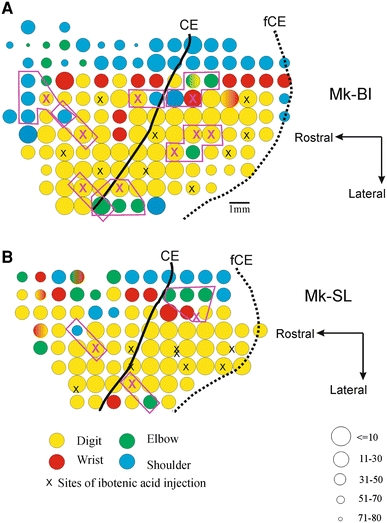Fig. 6.

Representative unfolded ICMS maps (in the left hemisphere) of the forelimb before lesion, derived from two animals, Mk-BI (a) and Mk-SL (b), with positions of ICMS sites selected for infusion of ibotenic acid (x symbols) to produce the lesion of the hand area. The method to unfold the rostral bank of the central sulcus has been described previously (Kaeser et al. 2010). As several electrode tracks running within the same rostrocaudal plane along the rostral bank of the central sulcus are projected on the same line segment, some ICMS sites and/or sites of ibotenic acid infusion may be superimposed. On these surface maps, a few ICMS sites eliciting contralateral finger movements (yellow circles), where ibotenic acid was infused, appear to be located close (less than 2 mm) to ICMS sites corresponding to representation of proximal muscles (elbow and shoulder, green and blue circles, respectively). Such sites of infusion of ibotenic acid are depicted by the purple x symbols. The real distance between such sites of infusion of ibotenic acid and the proximal ICMS sites (identified on the maps by purple polygons) was calculated from the original 3D coordinates system. These distance data are presented in Fig. 7 and Table 2. CE central sulcus, fCE fundus of the central sulcus. As coded on the bottom right corner, the size of the circles represents the ICMS threshold at which the just noticeable movement was observed. The body territory (digit, wrist, elbow or shoulder) activated by the ICMS is given by the color code (bottom left). For clarity, at the periphery of the forelimb representation, sites eliciting movements of other territories (e.g. face) or unresponsive were not represented
